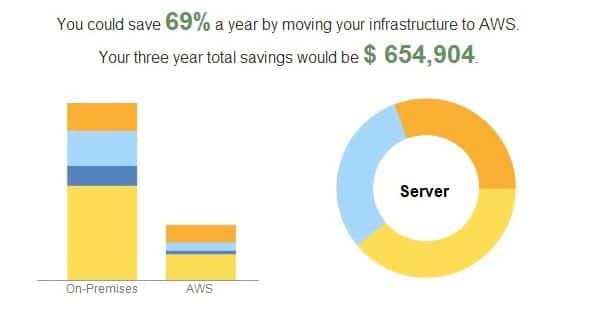Welcome to number three in our series of four blogs on mistakes commonly made in AWS database migrations. You can read the first two blogs, “Failing to Set Clear Goals,” and, “Failing to Evaluate All AWS Database Options,” and download our eBook for further details on all four.
Table of Contents
Optimize your AWS Database Migration to Reduce Costs
One well-known benefit of cloud computing is the ability to translate capital expenses to operating expenses. Moving to AWS in a simple “lift and shift” manner will achieve this objective. However, optimizing your AWS architecture can further reduce costs by as much as 80%.
Determine Total Cost of Ownership
Weighing the financial considerations of owning and operating a data center facility versus employing Amazon Web Services requires detailed and careful analysis.
AWS has a calculator you can use to estimate your Total Cost of Ownership in moving to the cloud. The TCO website states, “Our TCO calculators allow you to estimate the cost savings when using AWS and provide a detailed set of reports that can be used in executive presentations.” The TCO Calculator is an excellent tool to start off with.

The AWS TCO Calculator can provide an instant summary report which shows you the three year TCO comparison by cost categories.
Include Both Direct and Indirect Costs of AWS Database Migration
Network World published four steps to calculating the true cost of migrating to the cloud. As part of step 1, “Audit your current IT infrastructure costs,” author Mike Chan writes, “You should take a holistic approach and consider the total cost of using and maintaining your on-premise IT investment over time, and not just what you pay for infrastructure. This calculation will include direct and indirect costs.”
And the same considerations must be made in calculating your costs when considering your unique approach to migration.
Pay Only for What You Use, Use Only What You Need
AWS customers pay only for computing resources consumed. But to fully leverage this benefit, you must be sure you’re not consuming more than necessary.
For example, enterprises often size servers to support peak use to ensure high availability. But rather than remaining sized for max processing, you can code your apps to support the elasticity offered by AWS. Such adjustments could include rearchitecting a processing engine to process on a smaller machine, or shutting it down to create a bigger machine, or processing across ten machines if the architecture supports partitioning.
Taking full take advantage of this requires the expertise of a knowledgeable AWS partner.
AWS Database Options
While AWS easily hosts a variety of licensed databases, just shifting your databases to an Amazon EC2 instance will require you to continue paying those licensing fees. But by selecting AWS database options, such as Redshift and Aurora, you can eliminate many of those existing license fees. This often requires you to also move your existing logic, structure, and code, which can be both time-consuming and expensive to convert to another platform.
However, the savings can be very high, enabling a quick return on investment.
Ensure You’re Not Leaving Money on The Table
Rearchitecting requires both time and a financial investment. Many organizations lack the expertise in-house to conduct the re-architecture properly. It’s therefore difficult to determine the cost of making changes, and the potential savings that could result.
By analyzing your existing bills and structure, a skilled AWS partner like dbSeer can estimate potential cost savings by taking these types of steps. Contact us and we’ll help figure out how you can save every penny possible.




